If you’ve read any biographical information about Dr. Gregg, you’ll know that when he was quite young he had a legal dispute with Thomas Malone, another shorthand inventor/teacher who had authored “Script Phonography”. Dr. Gregg worked as a teacher for Malone, and when Gregg created his own system Malone took him to court over the rights to the “light line” system that Gregg produced.
Gregg left the UK, and Malone never prevailed in court. I’ve always wondered about the basis for this dispute, and recently found a later printing of Malone’s system on Amazon. It’s the 29th edition (amazingly) and published by Clark’s College in London, “The Proprietors of the System”. No date, unfortunately, but I’d estimate 1910 or so.
There are clearly some philosophic similarities with Gregg shorthand. The outlines are different, but the principles seems much the same. The systems clearly diverge, though, because Malone used shading (called “thickening” in the text) to distinguish “s” and “z” for instance. So clearly he did not maintain the “light line” principle, as Gregg did.
Here are a couple of pages from the book, one presenting the alphabet, and the other presenting principles of joining.


How interesting! Was this the same guy that scammed Gregg out of his early method? I suppose it was a blessing in disguise. He really went on to perfect a method that was very logical. This is a great find. I had no idea it was still in existence.
It's a bit hard to sort out the history. Malone was older, and Gregg worked for him as a shorthand teacher. But it's not clear who developed what, or who had the rights to what. Did they collaborate? Did they liberally borrow from each other? No way to know. It's certain that Gregg developed a more elegant system, and developed a much better way to market it to the world.
Thanks! Very interesting.
I see in the photos that weird joinings appear in Malone's system as "kr" or "kl" and "tr" produces an obtuse angle which reduces speed in writing.
Gregg is definitely more refined and functional . . . but it is eerie how some of the Malone outlines look like Gregg outlines, even if they represent quite different words.
Fascinating! Looks like Gregg could have, at the very least, been inspired by Malone's work. The complexity of some of alphabetic strokes reminds me somewhat of what I've skimmed of the Deutsche Einheitskurzshrift. I agree with Lee, it is funny how some of the outlines look so much like Gregg, even though they represent very different words.